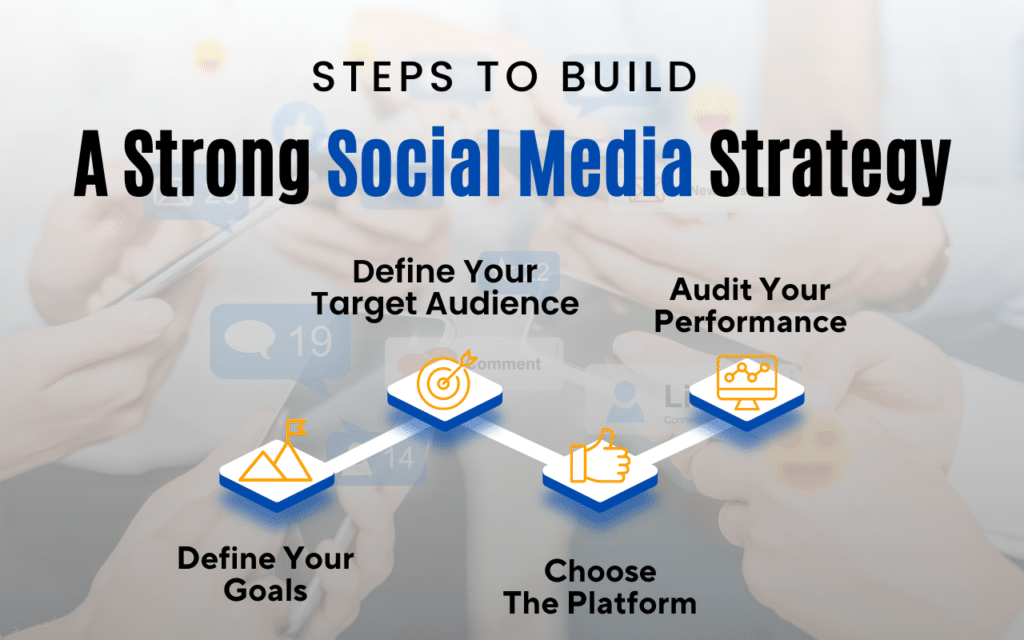8 Tips To Creating A Successful Social Media Marketing Campaign
You want to create a social media marketing campaign, but you want it to be successful, right? You, my friend, have arrived at the right place! In this guide, we’ll teach you everything you need to know about creating a social media marketing campaign that will motivate people to take the desired action.
But before we get started, let’s take a moment to talk about the importance of social media marketing.
Social media has become an essential part of our lives. We use it to connect with friends and family, to stay up-to-date on the latest news, and to find information about products and services.
As a result, social media marketing has become a powerful tool that can help businesses of all sizes reach new customers, grow their brands, and increase sales.
In fact, according to a study by Social Media Examiner, 92% of businesses use social media for marketing, and 80% of businesses say that social media has helped them increase brand awareness.
So, if you want to increase your sales, grow your brand, and reach new customers, you need to create a social media marketing campaign. And that’s where this guide comes in.
In this guide, we will teach you how to create social media marketing campaigns that are:
- Effective: Your social media marketing campaign should be designed to achieve specific goals, such as increasing brand awareness, generating leads, or driving sales.
- Engaging: Your social media marketing campaign should be engaging and interesting so that people will want to interact with them.
- Measurable: You should be able to measure the results of your social media marketing campaigns so that you can see what is working and what is not.
By following the tips, you can create social media marketing campaigns that will help you achieve your business goals.
So what are you waiting for? Let’s get started!
Table of Contents
What Is Social Media Marketing Campaign?
A social media marketing campaign is a coordinated effort to use social media platforms to achieve a specific marketing goal. This could include increasing brand awareness, generating leads, or driving sales.
Social media marketing campaign typically involve creating and sharing content, running social media ads, and engaging with followers. The goal is to create content that is relevant to your target audience and that will encourage them to take action, such as visiting your website, signing up for your email list, or making a purchase.
A successful social media marketing campaign can help businesses to:
- Increase brand awareness
- Generate leads
- Drive sales
- Improve customer loyalty
To create a successful social media marketing campaign, you need to follow these tips:
Tips for Creating a Successful Social Media Campaign
1. Understanding Your Target Audience
- The first step in creating a successful social media marketing campaign is to define your target audience. Who are you trying to reach with your campaign? What are their interests? What are their demographics? What are their needs and pain points?
Once you have a good understanding of your target audience, you can create content and messaging that will resonate with them.
- One way to define your target audience is to create buyer personas. Buyer personas are fictional representations of your ideal customers. They should include information about their demographics, psychographics, and buying habits.
By creating buyer personas, you can get a better understanding of the people you’re trying to reach with your social media marketing campaign.
2. Setting Clear Goals and Objectives
- Establish SMART Goals: When setting social media goals, it’s important to make sure they are SMART. This means that they should be Specific, Measurable, Achievable, Relevant, and Time-bound. This means that your goals should be clear, quantifiable, realistic, and have a deadline.
For example, a SMART goal for increasing brand awareness might be to increase your social media following by 10% in one month.
- Define Key Performance Indicators (KPIs) to track progress: KPIs are metrics that you use to measure your progress toward your goals.
For example, if your goal is to increase brand awareness, you might track KPIs such as social media following, website traffic, and engagement.
- Align goals with overall business objectives: Your social media marketing goals should be aligned with your overall business objectives. This means that your goals should support your business’s mission, vision, and values.
For example, if your business’s goal is to increase sales, your social media marketing goal might be to generate leads.
3. Choosing the Right Social Media Platforms
Here is a brief overview of some of the most popular social media platforms and their audience demographics:
- Facebook: Facebook is the most popular social media platform in the world, with over 2.9 billion active users. It is a good platform for businesses that want to reach a large audience, especially those that target consumers.
- Twitter: Twitter is a microblogging platform with over 330 million active users. It is a good platform for businesses that want to share short, timely updates with their audience.
- Instagram: Instagram is a photo and video-sharing platform with over 1 billion active users. It is a good platform for businesses that want to share visually appealing content with their audience.
- LinkedIn: LinkedIn is a professional networking platform with over 830 million active users. It is a good platform for businesses that want to connect with potential customers and employees.
- YouTube: YouTube is the world’s largest video-sharing platform with over 2 billion active users. It is a good platform for businesses that want to share video content with their audience.
Once you have a basic understanding of these different social media platforms, you need to evaluate which ones are the best fit for your target audience and campaign goals.
Once you have evaluated all of the factors, you can start to select the optimal platforms for your campaign. It is important to choose a mix of platforms that will reach your target audience and help you to achieve your goals.
For example, if you are a B2B company that wants to generate leads, you might want to use LinkedIn and Twitter. If you are a B2C company that wants to increase brand awareness, you might want to use Facebook and Instagram.
It is also important to experiment with different platforms and see what works best for your business. The best social media platforms for your business may change over time as your audience and goals change.
4. Crafting a Compelling Strategy

- Developing a unique value proposition and brand identity: The first step is to develop a unique value proposition and brand identity. This will help you to stand out from the competition and connect with your target audience. Your value proposition should be clear, concise, and easy to understand.
It should explain what makes your business or brand different from the rest. Your brand identity should be consistent across all of your social media channels. It should include your logo, colors, fonts, and tone of voice.
- Defining the tone, voice, and style of your content: Once you have developed your value proposition and brand identity, you need to define the tone, voice, and style of your content.
Your tone should be consistent with your brand identity. It should be friendly, professional, or humorous, depending on your target audience. Your voice should be authentic and engaging.
It should reflect your personality and the personality of your brand. Your style should be visually appealing and easy to read. It should be consistent with the overall look and feel of your brand.
- Creating a comprehensive strategy that aligns with your goals and resonates with your audience: Once you have defined the tone, voice, and style of your content, you need to create a comprehensive strategy that aligns with your goals and resonates with your audience. Your strategy should include the following:
- Content calendar: This will help you to plan and schedule your content in advance.
- Content types: This will help you to determine what types of content you will share on social media.
- Content frequency: This will help you to determine how often you will share content on social media.
- Content promotion: This will help you to promote your content and reach a wider audience.
By following these tips, you can craft a compelling social media strategy that will help you to achieve your business goals.
5. Creating Engaging Content
- Understanding different content formats and their effectiveness: There are many different types of content that you can create for social media, including:
- Text: This is the most common type of content and can be used to share news, updates, and information.
- Images: Images are a great way to capture attention and can be used to share stories, products, and services.
- Videos: Videos are a powerful way to tell stories and can be used to educate, entertain, and engage your audience.
- Infographics: Infographics are a great way to share complex information in a visually appealing way.
- Podcasts: Podcasts are a great way to share long-form content and can be used to interview experts, share stories, and provide education.
When choosing a content format, it is important to consider your target audience and your goals.
For example, if you are targeting a younger audience, you may want to use more images and videos. If you are targeting a business audience, you may want to use more text and infographics.
- Crafting captivating headlines and introductions: Your headline is the first thing that people will see, so it is important to make it count. A good headline will be clear, concise, and attention-grabbing.
It should also give people a good idea of what your content is about. Your introduction is also important. It should be clear, concise, and engaging. It should also give people a good reason to read the rest of your content.
- Incorporating visual elements, storytelling techniques, and user-generated content: Visual elements are a great way to capture attention and make your content more engaging. You can use images, videos, infographics, and even GIFs to add visual interest to your content.
Storytelling is another great way to engage your audience. People love stories, so using storytelling techniques in your content can help you to connect with them on a deeper level.
User-generated content is also a great way to engage your audience. When you share user-generated content, you are showing your audience that you value their input and that you are interested in what they have to say.
By following these tips, you can create engaging content that will capture the attention of your audience and keep them coming back for more
6. Implementing Effective Tactics
- Leveraging influencer marketing and partnerships: Influencer marketing is a great way to reach a new audience and build credibility. When you partner with an influencer, you can tap into their following and expose your brand to a whole new group of people.
When choosing an influencer, it’s important to find someone who is a good fit for your brand and has a following that is interested in what you have to offer. You should also make sure that the influencer is active on social media and has a good engagement rate.
Once you’ve found an influencer, you can work with them to create content that promotes your brand. This content can be anything from blog posts to social media posts to videos.
- Utilizing hashtags, keywords, and SEO strategies: Hashtags are a great way to categorize your content and make it easier for people to find. When you use a hashtag, your post will be grouped with other posts that use the same hashtag. This can help people find your content and connect with others who are interested in the same things.
Keywords are words or phrases that people use to search for information online. When you use the right keywords in your content, you can help people find your website or blog when they are searching for information about your topic.
To use hashtags, keywords, and SEO strategies effectively, you need to do your research and understand what your target audience is searching for. You should also use a variety of hashtags and keywords in your content.
- Engaging with your audience through contests, polls, and live events: Engaging with your audience is essential for any successful social media marketing campaign. When you engage with your audience, you can build relationships, get feedback, and generate excitement about your brand.
There are many different ways to engage with your audience on social media. Some popular methods include: - Running contests
- Conducting polls
- Hosting live events
When running a contest, you can offer prizes to the winners, which will encourage people to participate. When conducting a poll, you can ask people questions about their preferences and get valuable insights into what they want. When hosting a live event, you can meet your customers face-to-face and create a more personal connection.
7. Analyzing and Measuring Campaign Performance

- Tracking and analyzing key metrics using social media analytics tools: There are many different social media analytics tools available, each with its own strengths and weaknesses. Some popular tools include Google Analytics, Hootsuite Analytics, Sprout Social, and Buffer.
When choosing a social media analytics tool, it’s important to consider your needs and budget. You should also make sure that the tool you choose can track the metrics that are important to you.
Once you’ve chosen a social media analytics tool, you can start tracking your key metrics. Some of the most important metrics to track include Engagement, Reach, Conversions, and ROI.Engagement is a measure of how people are interacting with your content. This can include things like likes, comments, and shares.
Reach is a measure of how many people are seeing your content. This can include people who see your content on their own timelines, as well as people who see it in their newsfeeds.
Conversions are a measure of how many people are taking the desired action after seeing your content. This could be anything from visiting your website to making a purchase.
ROI is a measure of the return on your investment. This is calculated by dividing the amount of money you spent on your campaign by the amount of money you generated from it.
- Monitoring engagement, reach, conversions, and ROI: Once you’re tracking your key metrics, you can start monitoring them to see how your campaign is performing. You should check your metrics regularly and make adjustments to your campaign as needed.
For example, if you’re not seeing enough engagement, you may need to change your content or the way you’re promoting it. If you’re not seeing enough reach, you may need to target your audience more effectively. If you’re not seeing enough conversions, you may need to make your call to action more clear.
- Making data-driven adjustments and optimizations based on insights: Once you’ve analyzed your key metrics, you can start making data-driven adjustments and optimizations to your social media marketing campaign.
For example, if you found that your content was more engaging on Instagram than on Facebook, you may want to focus your efforts on Instagram. Or, if you found that your call to action was confusing, you may want to make it clearer.
8. Adapting to Changing Trends and Algorithms
- One of the best ways to ensure that your social media campaigns are successful is to stay up-to-date with the latest trends and features. This means following industry blogs and news sources, attending industry events and conferences, and engaging with social media platforms directly.
By staying informed about the latest changes, you can make sure that your content is relevant and engaging to your target audience.
- Adapt strategies to algorithm changes and platform updates: Social media platforms are constantly updating their algorithms and features, which can have a significant impact on the reach and visibility of your content. It’s important to regularly monitor your social media analytics to identify any changes in performance.
If you notice that your content is no longer reaching as many people, it may be time to adapt your strategies. This could involve changing the types of content you share, the times of day you post, or the hashtags you use.
- Experimenting with new content formats and techniques: One of the best ways to stay ahead of the curve is to experiment with new content formats and techniques. This could involve using video, live streaming, or interactive content. By experimenting, you can find new ways to engage your audience and drive results.
Conclusion
Creating a successful social media marketing campaign requires a lot of hard work and dedication. However, by following the tips in this blog post, you can increase your chances of success.
Here is a recap of the key steps to create a successful social media marketing campaign:
- Set clear goals.
- Target your audience.
- Create high-quality content.
- Post regularly.
- Use social media analytics to track your progress.
Social media is a constantly evolving landscape, so it’s important to be willing to learn and adapt as needed. If you want to achieve sustained success with your social media marketing campaign, you need to be willing to experiment with different strategies and tactics.
The most important step is to take action and implement the strategies you’ve learned. Don’t just read this blog post and then do nothing.
With a little effort and perseverance, you can create a successful social media marketing campaign that will help you achieve your business goals.
Still, struggling to get results from your social media marketing campaign? Contact Nargish Digital today and let us help you reach your target audience and grow your business.” – Click Here Now!



Thinker Pedia Great information shared.. really enjoyed reading this post thank you author for sharing this post .. appreciated
Blue Techker I truly appreciate your technique of writing a blog. I added it to my bookmark site list and will